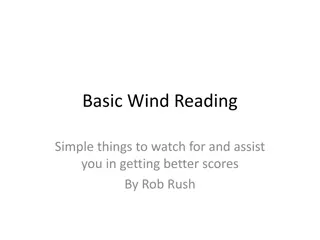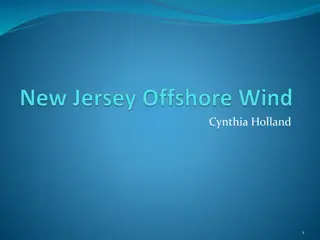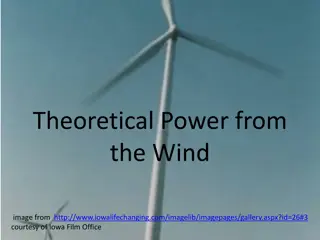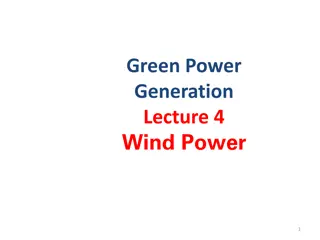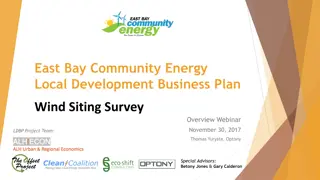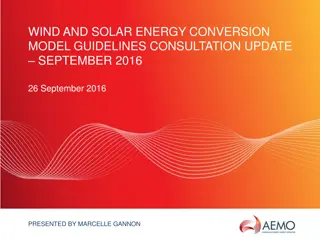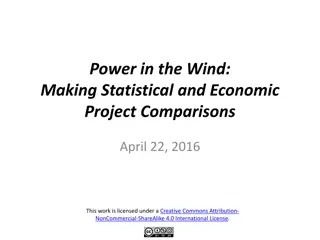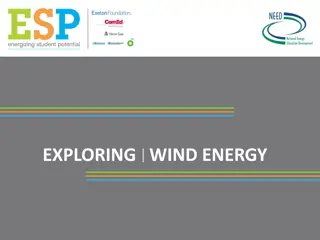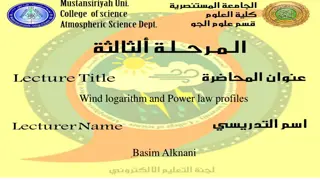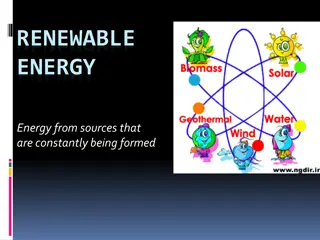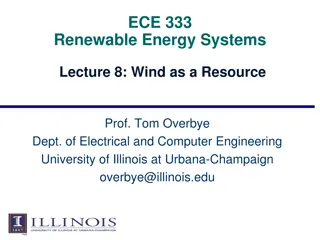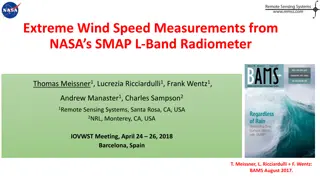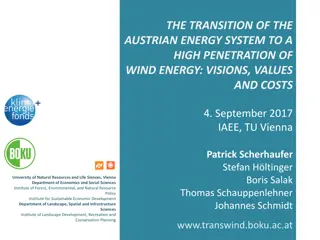Commercial Wind Energy Basics
This content discusses the fundamental aspects of commercial wind energy, covering topics such as different types of wind turbines, their components, operational principles, and environmental considerations. It explores the distinction between Horizontal-axis wind turbines (HAWT) and Vertical-axis wind turbines (VAWT), detailing their designs, efficiencies, and functionalities. Through images and descriptions, it aims to enhance the reader's understanding of wind energy generation and its key components.
Download Presentation

Please find below an Image/Link to download the presentation.
The content on the website is provided AS IS for your information and personal use only. It may not be sold, licensed, or shared on other websites without obtaining consent from the author.If you encounter any issues during the download, it is possible that the publisher has removed the file from their server.
You are allowed to download the files provided on this website for personal or commercial use, subject to the condition that they are used lawfully. All files are the property of their respective owners.
The content on the website is provided AS IS for your information and personal use only. It may not be sold, licensed, or shared on other websites without obtaining consent from the author.
E N D
Presentation Transcript
Commercial wind COMMERCIAL WIND ENERGY Except where otherwise noted these materials are licensed Creative Commons Attribution 4.0 (CC BY)
The objective of this unit is to present the student with some basic terms relating to energy, efficiency, and conservation. Upon completion, the student will have an understanding of the following: Electrical generation HAWT and VAWT Various component in a turbine Objectives Siting study Wind quality Operational limits Environmental concerns Commercial Wind
Two main types of wind turbines: 1. Horizontal-axis wind turbine I. More efficient than the vertical axis turbine II. The turbine is mounted on top of a tower. III. It can have one, two, three ,or multiple blades, with three being the most common. IV. The wind blows through the blades causing them to rotate. V. The rotor and blades of the horizontal wind turbine are connected to the generator by a shaft. 2. Vertical-axis wind turbine One of the most common types is the Darrieus. The Darrieus is shaped like an egg beater and uses lift forces on its blades to get them to turn. III. The design allows the blades to rotate at higher speeds than the wind. IV. Will rotate and produce electricity regardless of wind direction V. The disadvantage of the design is that it needs a motor to get started. HAWT vs VAWT I. II. Commercial Wind
HAWT & VAWT Ssgxnh [Public domain]. Retrieved from https://commons.wikimedia.org/wiki/File:HAWT_and_VAWTs_in_operation_medium.gif Commercial Wind
HAWT Components Tennessee Valley Authority [Public domain]. Retrieved from https://en.wikipedia.org/wiki/File:Wind_turbine_diagram.svg Commercial Wind
Components defined: The tower is the structure that holds the nacelle. The blades capture the wind and turn the low speed shaft. The rotor holds the blades and assists with turning the blades. The brake will lock down the system when it stops turning. The low-speed shaft transfers energy from the rotor. The high-speed shaft receives the energy from the low speed shaft. The yaw drive is the gear used to turn the nacelle. The yaw motor is used to turn the nacelle. The gear box connects the high speed shaft to the generator. The generator produces electricity for use by customers. The anemometer determines the speed of the wind. The wind vane will determine wind direction. Components Commercial Wind
In a HWAT electricity is generated in the following manner: 1. The wind blows past the blades, and they begin to rotate. 2. As the blades rotate, they convert the power of the wind to rotational force called torque. 3. The torque from the blades is transmitted through the low-speed shaft to the gearbox. 4. The gear set in the gearbox causes the output shaft to turn at a much higher speed. 5. The generator is connected to the other end of the high speed shaft and turns at the higher speed to produce AC voltage. 6. The nacelle has a control system that allows it to be rotated so that the blades stay positioned. By doing this they are always directed into the wind (yaw). 7. The yaw control consists of a large circular plate with teeth in it that is mounted to the bottom of the nacelle. 8. The yaw motor turns the nacelle in and out of the wind as needed for safety and speed control. 9. The blades on the rotor also have the ability to rotate on the rotor. This allows for the blades to be positioned. 10. The tower has sensors that provide input to a control system, which maintains proper operations. Creation of Electricity Commercial Wind
The main objective of the siting process is to locate a wind turbine (or turbines) so the net revenue is maximized while minimizing noise, environmental, visual impact, and overall energy cost. There are five stages to the process: 1. Identification of specific geographic areas that need to be studied further 2. Select possible sites from an engineering and community perspective. 3. Preliminary evaluation of sites, which includes ranking in terms of economic potential, environmental impact, safety, public acceptance, and many other variables. Siting study 4. Final site evaluation involves making measurements to determine the best site. Measurements should include wind shear, turbulence, wind speed, and prevailing wind direction. 5. Micrositting takes place once the site is chosen. This process involves computer programming that places the turbines. Commercial Wind
Problems that may adversely affect a sites suitability: 1. Economic issues I. Access rights, taxes 2. Topographical I. Road access, slope 3. Legal issues I. Ownership, zoning 4. Permitting I. Permits required, time frames 5. Geological I. Foundation design, ground resistance for lightning protection Siting study 6. Environmental I. Sensitive areas, bird fly-ways 7. Public acceptance I. Safety, noise impacts, distance from residences 8. Safety issues I. Proximity to populated areas 9. Interconnection issues I. Proximity to power lines, voltage, and current capacities of lines Commercial Wind
Wind quality is a measure of the suitability of wind conditions to generate electricity; it depends on a couple parameters: 1. Strength of wind: wind speed in the range of 10-40 mph will provide suitable power without causing too much fatigue on components. Winds less than 10mph offer minimal power, and wind over 40mph are dangerous and require shutdown. 2. Uniform flow: The wind needs to be free of turbulence to produce electricity. The rotating blades cannot adjust fast enough, and the kinetic energy in the wind becomes wasted. Wind Quality Commercial Wind
The rotor of the wind turbine extracts kinetic energy from moving air and converts it to rotational kinetic energy turning a shaft. The power available depends on three parameters: 1. Wind speed: The wind speed determines the kinetic energy of the air and the rate at which it strikes the blades of the rotor. 2. Rotor area: The amount of wind captured by a rotor is the area swept out during its rotation. Power from Wind 3. Density of air: The denser the air, the greater the impact wind will have when it strikes the blade. Power= ( ) x (Density) x (Area) x (Wind Speed)3 Commercial Wind
Turbines will vary; however, all turbines must incorporate methods of limiting operation to safe speeds. Common terminology one will encounter include: 1. Cut-in speed, which is the minimum speed to initiate rotation and produce power. 2. Cut-out speed is the maximum speed, and the turbine must be shut down when it reaches this. Operational Limits 3. Operational wind speed is the range between cut-in and cut-out speeds. 4. Rated wind speed is the range the turbine will operate at its peak. K. Eurek, P. Sullivan, M. Gleason, D. Hettinger, D. Heimiller, A. Lopaz. National Renewable Energy Laboratory [Public domain]. Retrieved from https://www.osti.gov/pages/servlets/purl/1364059 Commercial Wind
Large wind turbines limit excess speed in three ways: 1. Pitch-Control: Variable-pitch turbines will alter the alignment of the blades with respect to the wind, turning them more parallel to the wind so that it slips past without generating lift on the blade. 2. Stall Control: Variable pitch turbines may alter the blade alignment so they are more perpendicular to the wind direction. The process is known as stalling and creates a lot of stress on the turbine. Speed control 3. Passive stall: Used with a fixed pitch blade where the blades are designed to create turbulence naturally at excessive wind speeds Commercial Wind
The environmental impact of wind energy production itself is fairly minimal. Some of the major concerns expressed are: 1. Noise I. II. All wind turbines make some noise. Large turbines produce noise at a lower frequency than residential turbines. 2. Effect on land use I. The deforestation of wilderness areas for wind power is a legitimate concern. Environmental Concerns 3. Effect on wildlife I. Birds and bats are at risk from wind turbines. However, plate glass windows and automobiles pose more of a risk. 4. Aesthetics I. A wind farm will change the appearance of the landscape and should be considered when building a wind farm. Commercial Wind
Typical system Jalonsom [CC BY-SA 3.0]. Retrieved from https://commons.wikimedia.org/wiki/File:Wind_turbine_schematic.svg Commercial Wind
Upon completion of this unit, students should be able to Describe the components in a turbine Discuss wind quality Identify operational limits Summarize the siting process Explain the basic grid connection Conclusions This presentation was prepared by Northeast Iowa Community College under award EG-17-004 from the Iowa Energy Center. Any opinions, findings, and conclusions or recommendations expressed in this material are those of the author(s) and do not necessarily reflect the views of the Iowa Energy Center. Commercial Wind
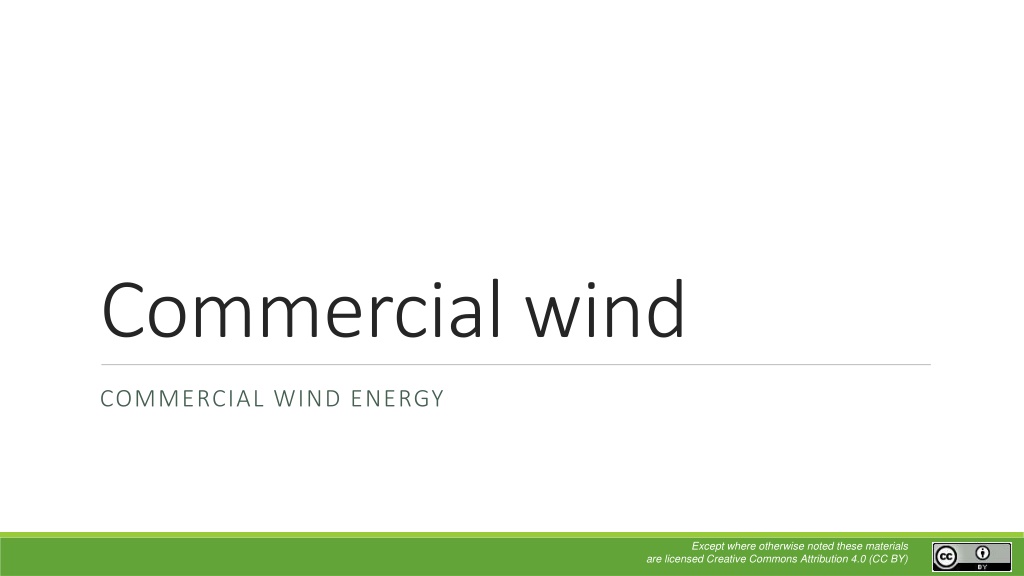
 undefined
undefined





